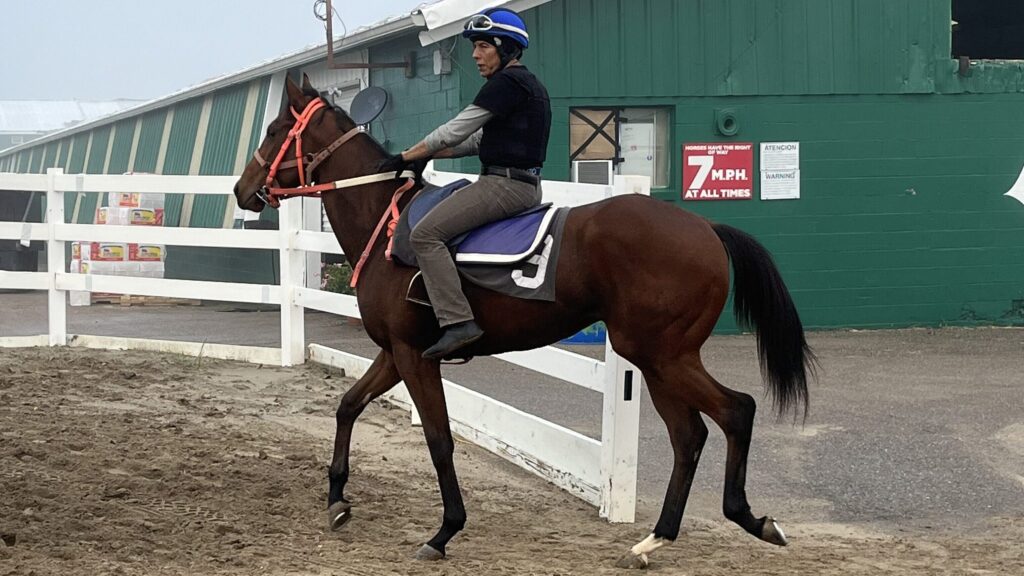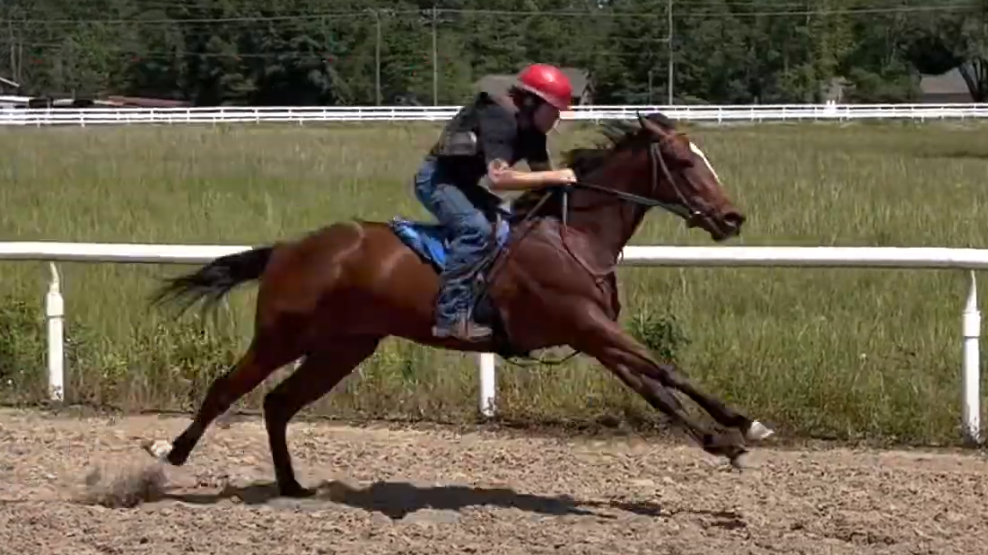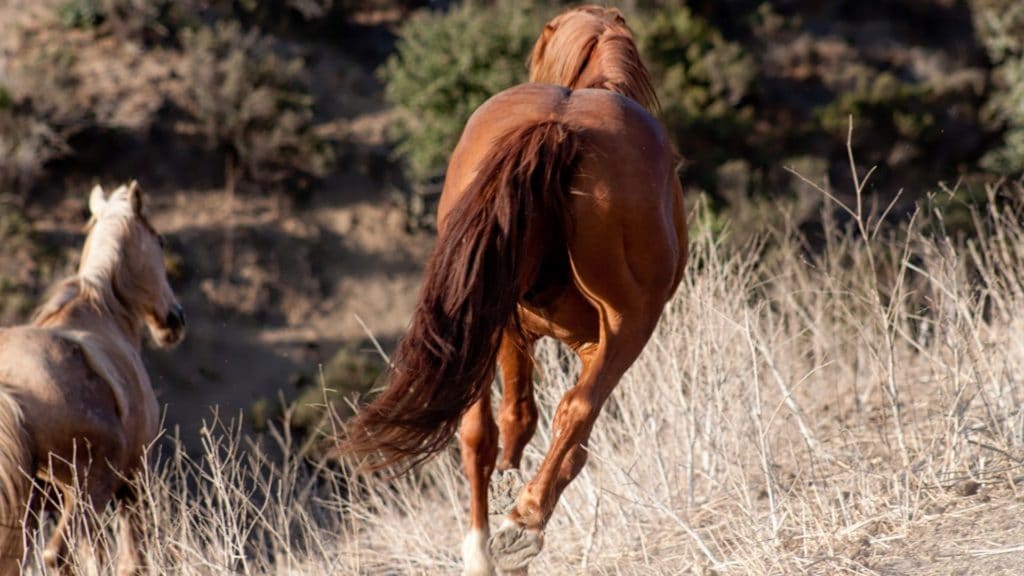Last updated: June 13, 2023
Horses have long been admired for their blend of power, speed, and endurance. Their prowess is evident everywhere, from the ancient battlefield charges to the thrilling races at today’s modern tracks. Yet, one question often arises about these amazing athletes: just how far can a horse run without stopping?
On average, a fit and healthy horse can run approximately 2 to 2.5 miles at full speed without stopping, though certain exceptional equines have been reported to cover distances up to 5 miles. It’s important to note that these figures are influenced by a myriad of factors, including the horse’s breed, health status, and environmental conditions.
Ready to venture further into this equine endurance mystery? Journey with me as we unravel the intricate factors that dictate a horse’s running distance and explore the scientific secrets behind their impressive long-distance capabilities.
A Horse’s Body is Built for Running
To fully appreciate a horse’s endurance and speed, we need to delve into their unique physiology. Horses, by nature, are built for running. Their large and powerful heart, robust lungs, and long, muscular legs contribute to their exceptional stamina and velocity.

One significant factor influencing a horse’s running capacity is its breed. Different breeds exhibit different physical characteristics and athletic abilities. For instance, the Thoroughbred, bred for speed and endurance, can sustain high speeds over longer distances than most other breeds, making them a staple in horse racing. Conversely, Quarter Horses are known for their short, intense bursts of speed, excelling in sprinting.
A horse’s age and health condition also play vital roles. Younger, healthy horses typically have better stamina and speed compared to older or health-compromised equines. As horses age, they may develop conditions like arthritis that can limit their running capacity. Regular vet checks and proactive health management are key to maintaining a horse’s optimal running condition.
Finally, the training and care a horse receives greatly impact its running capacity. Regular, well-planned exercise can enhance a horse’s endurance, while inadequate or improper training can lead to fatigue and injuries. Moreover, a balanced diet and proper hydration are crucial in fueling a horse’s body for sustained running.
Understanding these factors allows us to better appreciate the horse’s remarkable endurance and speed. It’s not just about their inherent physical characteristics but also about the influence of their breed, health, age, and the care they receive.
How Far Can a Horse Run Without Stopping?
The ability of a horse to run without stopping is an interplay of numerous factors, encompassing its breed, age, fitness level, running pace, and environmental conditions.
On average, a healthy and well-trained horse can run about 2 to 2.5 miles at full speed without halting. Still, this top-speed sprint isn’t typically sustained unless under racing circumstances. Remarkably, some horses, when prepared for endurance, have demonstrated the capacity to cover distances up to 20-25 miles without stopping, though at a slower pace like a trot or canter.
It’s important to remember, however, that these are averages, and every horse is distinct. The running distance of individual horses without stopping can substantially vary based on the factors mentioned.
The running pace significantly determines a horse’s non-stop running distance. Comparable to marathon runners who manage a steady speed, horses, too, need to regulate their pace to stretch their distances. A slower, consistent trot or canter enables a horse to conserve energy, allowing them to run farther than when galloping at full speed.
Environmental conditions, including weather and terrain, also wield considerable influence. Cooler temperatures favor a horse’s ability to run longer distances as they prevent rapid fatigue from overheating. Likewise, a horse can conserve energy and run farther on flat, smooth terrains, unlike on uneven or hilly grounds.
Such assertions are supported by various scientific studies and real-life examples. A study published in the Journal of Applied Physiology highlights how cooler weather can boost racehorse performance. On the other hand, the Mongol Derby, the world’s longest horse race, showcases the effects of terrain and pace management on a horse’s ability to cover a course of approximately 1000 km.
In essence, while horses are naturally endowed with endurance, their capacity to run non-stop is shaped by multiple factors. Understanding these influences provides a well-rounded view of equine endurance.

How Long Can a Horse Run Full Speed?
Maintaining full speed is a demanding task, even for a horse. The length of time a horse can keep this up largely depends on its fitness level and genetics. Take racehorses, for instance. These equine athletes are bred and trained specifically to cover long distances at high speeds. In fact, a fit racehorse can maintain a full-out gallop for up to two miles.
You might have observed that many race winners aren’t the quickest off the starting line. Rather, they often come from behind to clinch victory. The secret? Energy conservation. A skilled jockey knows when to let their horse settle and relax, saving energy for a final burst. This strategy capitalizes on the fact that those horses that sprinted at the start will likely tire and slow down later in the race.
However, racehorses aren’t the only ones who can sustain a brisk pace for a good distance. Certain non-racing breeds, particularly Arabians, renowned for their stamina, can also keep up a fast pace over several miles, especially if they’re in peak condition and not burdened with excessive weight.
So, while there’s no one-size-fits-all answer to how long a horse can run at full speed, it’s safe to say that a well-conditioned horse can keep up a strong pace for several miles before requiring a break.
Horse’s Speed: How Fast Can They Run?
The allure of a horse’s speed is as captivating as its endurance. Watching a horse gallop full-tilt is an adrenaline-fueled experience, demonstrating a raw display of power, grace, and speed. So, just how fast can these equine athletes run, and for how long can they sustain their top speeds?
An average horse can reach a top speed of about 25-30 miles per hour. However, some breeds are built for speed, with Thoroughbreds leading the pack. These racing icons have been clocked at impressive speeds, with the current record held by Winning Brew, who achieved an astounding speed of 43.97 miles per hour in a 2008 race.
The length of time a horse can maintain its top speed depends on its fitness, breed, and the conditions under which it’s running. Generally, horses can maintain their top speed for about 1 to 2 miles before they start to tire. However, this is influenced by factors such as training, health, and the nature of the race itself.
Insights from horse racing and scientific studies confirm these observations. An analysis of Thoroughbred race results published in the Journal of Experimental Biology found that horses tend to slow down after about 1 mile when running at top speed. This slowing down is likely due to fatigue and the body’s response to the physical exertion of running at such high speeds.
A horse’s speed is a marvel of nature, enhanced by careful breeding and meticulous training. The spectacle of a horse running at full speed is a testament to its incredible power and athletic ability.
During the early days of formalized horse racing, races were usually much longer than today. The great English racehorse Eclipse was undefeated in 18 races that averaged three and one-half miles. And he often carried a heavy rider weighing close to 170 pounds. His first win was a four-mile race at Epsom Downs.

The Science Behind a Horse’s Speed and Stamina
Several key elements influence a horse’s capacity for speed and endurance, chief among them being genetics and breed traits. Some horse breeds naturally possess greater speed and endurance compared to others due to specific genetic traits.
The first of these genetic factors lies in the horse’s limbs, particularly the long, spring-like tendons. If you’ve ever used a pogo stick, you might get an idea of how these tendons work. They provide the bounce, similar to the spring in a pogo stick, aiding the horse in propelling forward with energy. Unfortunately, human tendons lack this springy quality, restricting our speed significantly.
Next is the unique relationship between a horse’s stride and breath, often referred to as the one-to-one factor. Each stride a horse takes corresponds to a single breath. This efficient synchronization, combined with a specialized respiratory system that maximizes lung capacity, enables horses to maintain both speed and stamina over extended distances.
Moreover, factors like physical conformation, fitness level, and genetics all play pivotal roles in determining how fast and how far a horse can run. So while some of us may never know the exhilaration of a long, fast run personally, we can marvel at the intricate biological machinery that allows horses to do so with such ease and grace.

Taking Care of a Horse for Maximum Endurance and Speed
Like human athletes require the right care and maintenance for optimal performance, horses, too, need proper attention to reach their maximum potential in both endurance and speed. Let’s delve into the key aspects of horse care that contribute to these capabilities: diet and hydration, exercise and training, and rest and recovery.
First, diet and hydration play a critical role. A horse’s diet should be rich in quality forage, as this provides the energy necessary for prolonged exercise. In addition to forage, horses also require an appropriate balance of carbohydrates, fats, proteins, vitamins, and minerals. Ensuring horses have continuous access to fresh, clean water is crucial, as dehydration can significantly impact performance and overall health.
Second, exercise and training are the foundation of a horse’s physical capabilities. A balanced training regimen helps build strength, flexibility, and endurance. The regimen should include aerobic exercises for cardiovascular fitness, resistance work for muscle strength, and flexibility exercises to improve joint mobility and prevent injuries. Like humans, horses need a progressive training schedule, gradually increasing in intensity and duration to avoid overtraining and injury.
Lastly, rest and recovery are often overlooked but are as essential as diet and training. Horses, like all athletes, need sufficient downtime to allow their bodies to repair and strengthen. Adequate rest includes not only sleep but also relaxation and leisure time. It’s during these rest periods that the body repairs the micro-damage caused by intense training, making them stronger and better prepared for the next exercise session.
Taking care of a horse for maximum endurance and speed involves a comprehensive approach encompassing diet, training, and rest. By understanding and implementing these key elements of horse care, owners and trainers can help their horses reach their fullest potential.

The Dangers of Overextending Your Horse
Endurance riding is an exhilarating equestrian sport that sees riders covering substantial distances at a brisk pace. While this sport is thrilling for both rider and horse, it carries certain risks that need attention.
Overuse injuries stand as one of the prevalent risks tied to endurance riding. Excessive speed or prolonged periods of riding can put undue strain on the horse’s muscles, ligaments, and tendons. This strain can manifest as soreness, swelling, and, in severe instances, lameness. In extreme cases, an overworked horse may face life-threatening injuries.
Dehydration is another significant concern. Given that endurance riding entails extensive distances, horses can rapidly dehydrate without adequate water access. Dehydration can induce fatigue, muscle cramping, and even colic in horses. Consequently, endurance riders must closely monitor their horses’ hydration levels, ensuring regular opportunities for rest and hydration.
In essence, while enjoying the thrill of endurance riding, we must ensure we do not compromise the well-being of our horses. Riding responsibly, considering the horse’s physical limits, and providing adequate rest and hydration, can help prevent these unfortunate situations.
Can horses run so hard that their heart explodes?
Instances of horses dying suddenly following strenuous exercise or races are typically classified as “sudden deaths,” often linked to heart failure caused by ruptured arteries or vessels. It’s a stark reality that horses can indeed be pushed to run to such extremes that their hearts fail, sometimes explosively.
In most cases, the horses that succumb to these situations suffer from an underlying health issue, such as structural heart defects or irregular heart rhythms. Interestingly, certain horse breeds are more prone to heart irregularities, such as arrhythmias or murmurs.
A 2011 study published in the Equine Veterinary Journal examined “sudden deaths” in racehorses, offering insightful observations about this phenomenon. Here’s a link to the study: “Sudden death in racing Thoroughbred horses: An international multicentre study of post-mortem findings.“
Such consequences underline the importance of not pushing a horse beyond its limits during riding. Maintaining the health and well-being of our horses should always be the prime consideration for every rider.

Who Wins in the Long Run: Humans or Horses?
At first glance, it would seem that horses, with their impressive speed of up to 25 miles per hour, would easily outrun humans, who average a mere 7 miles per hour. However, the story unfolds differently when it comes to endurance races over much longer distances.
Humans, over millennia, have evolved into phenomenal endurance runners. While a horse has an edge in a sprint, humans outshine them in races of 100 miles or more, for which horses aren’t naturally designed. Our unique capacity to regulate body heat through sweating allows us to run long distances without overheating, an advantage most other mammals don’t share.
This human advantage is exemplified in endurance races, such as the one in 2000 where long-distance runner Tomoe Abe completed a 100km run in a remarkable 6:33:11. Even though a horse may initially leave us in their dust, over extended distances, humans usually come out ahead.
However, there are exceptions, with some extraordinary horses occasionally outrunning humans in marathons. But these are relatively rare, and generally, humans can cover greater distances.
Of course, these comparisons are not universally applicable to all humans and horses. In diverse cultures and environments, various factors can affect this equation. But on a broad scale, while horses win in the sprint, humans take the laurels in the marathon.
Below is a YouTube video that answers the question of how long a horse can run without stopping.
Conclusion
In the riveting world of horse performance, the questions of how far a horse can run without stopping and at full speed unfold a fascinating tapestry of biology, sports science, and individual variability. From their natural physiological design to their exceptional training regimens, horses have shown us that they are indeed some of nature’s most impressive endurance athletes.
However, it’s important to remember that each horse is unique, and the precise distance and speed a horse can achieve depend on a multitude of factors, including breed, age, health, training, diet, rest, and environmental conditions.
As we’ve explored, ensuring a horse reaches its optimal performance involves a holistic approach that balances the right diet, adequate training, and sufficient rest and recovery. Such comprehensive care ensures the horse’s well-being and promotes their endurance and speed.
So, while we can offer averages and ranges, the magic of equines lies in their individual strengths, capabilities, and personalities. Whether your interest lies in horse racing, equestrian sports, or the joy of a companion, understanding the factors that influence a horse’s capacity to run provides a deeper appreciation for these magnificent animals and their remarkable abilities.
How long can a horse run in a day?
An average horse in good condition can cover about 50 miles in a day; however, well-trained endurance horses can travel 100 miles in a day.
How long can a horse run at maximum speed?
Horses can only maintain maximum speed for a relatively short distance, usually less than one furlong. However, they can run hard for about two miles.
Resources
- https://slate.com/culture/2012/06/long-distance-running-and-evolution-why-humans-can-outrun-horses-but-cant-jump-higher-than-cats.html
- https://en.wikipedia.org/wiki/Man_versus_Horse_Marathon
- https://www.npr.org/sections/health-shots/2015/10/20/450068114/heres-how-you-can-outrun-a-horse
- https://www.sciencedaily.com/releases/2008/09/080925072438.htm
- https://en.wikipedia.org/wiki/Persistence_hunting

About the Author: Miles Henry
Lifelong Horseman | Racehorse Owner | Published Author
Miles Henry brings over 25 years of hands-on experience training and owning Thoroughbred racehorses. Raised with Quarter Horses and Appaloosas, he’s spent a lifetime learning from horses—on the track, in the barn, and in the field. Today, he runs a small but successful racing stable in Louisiana and shares real-world insights on HorseRacingSense.com, helping horse owners, fans, and bettors navigate the sport with confidence.
📚 Books: View Miles’s books on Amazon »
🎧 Podcast Guest: Animal Tales Ep. 32 |
YouTube Interview
📩 Newsletter: Sign up for racing tips and horse care advice »
🔗 Follow Miles:
Twitter |
Facebook |
YouTube


